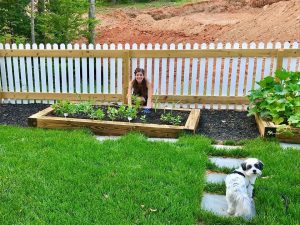My Garden Summer: Books to Blooms
By Sarah McCoy | June 25, 2019 |

Flickr Creative Commons: Judy Gallagher
This is my garden summer. If you follow me on Instagram, Facebook, or Twitter, you will quickly see that my posts have become progressively more vegetable and flower filled. In fact, that’s where I was just before sitting down to write this column: out in my garden, procrastinating with a hose and trowel under the auspice of these weeds can’t wait; then further distracted in my Google search on “How to get rid of June bugs on my roses?” (Answer: Neems oil!)
To most, it’s far from novel, in either of Webster’s definitions. But you must understand, this is my first garden. Yes, in all my life. So I pray you pardon my social media exclamations over squash blossoms, sprigs of basil, hydrangea plumes, and zinnias. Planting roots was never part of the gypsy life. Plus, for nearly a decade, we lived in El Paso where gardens were made of rocks and a handful of thorny desert rose bushes. When we moved, one of my biggest, ugly cries took place in my rose garden. It had brought me joy, comfort, and beauty when I needed it, and now I was leaving. It hurt—to have put so much time, energy, and love into something that I had to walk away from.
I had the added truth that every plant I had purchased or been gifted withered and died. I was grateful to friends who sent me constant replenishment. They knew me well—knew that I adore flowers. They are among my most favorite things on earth. But my black thumb was tried and true. For nearly four decades, I favored annuals. They came with a designated “going to die” stamp. Succulents were kind to me. They stayed around a little longer than the rest.
Then I moved to North Carolina. We built a farmhouse. We planted ourselves and wintered into our new home. This spring, we got our sod. Gorgeous stuff. I knew grass could thrive wild, but when it came to the gardens, I was terrified. Initially, I thought the safest route would be to put down river rock—everywhere. But then my mother reminded me of two things: 1) I come from green thumb people. My father’s kin were Oklahoma farmers and my mother is the daughter of a farming legacy in Puerto Rico. It was in my DNA… somewhere. 2) Planting a garden was not much different than writing a book. If I could do one, I could do the other, she said.
I argued against both. “DNA skips generations,” I told her, and a book and a garden were vastly different. For starters, a book was constructed in my temperature-controlled, weatherproofed writing office. A garden was open to Mother Nature’s whims. While I had no control over the former, I had a hand in the latter. I decided to give it a go. If only to say I had tried and look, more dead things.
I sat down with our landscaper and sketched out the basic property outline. Next, we moved to focal zones: the right side terrace, the backyard row, the left side circle; the front rose line, etc. I began to wonder if my mother wasn’t on to something. Go figure. I saw each area as a kind of chapter. In each, we determined the plant characters that would flourish best for the overall garden aesthetic.
My landscaper asked me, “What’s the message of your garden?” The message? I never realized gardens had messages to proffer.
I started looking around my neighborhood, on Pinterest boards, and Instagram #Gardens. Suddenly, a new realm appeared—like one of those 3D stereogram illusions. Each individual garden, no matter how large or small, was its own unique story. The herb boxes with varied parsleys, thymes, and lavender spoke to the owners’ taste. The lines of cukes, peppers, tomatoes, and strawberries gave a glimpse of their family’s supper table. The color, arrangement, and abundance of anemones, hollyhocks, peonies, and roses told me how they defined beauty. Even the shrubs, vines, mulch and rocks were character describing. How had I missed all of this?
 So I set my mind to constructing my garden story. I bought seed packets at the local dime store. I followed the basic instructions: planting at the right depth and watering often. Much like opening a fresh word document, sitting at the desk, putting my hands on the keyboard, and applying syntax fundamentals. I made it part of my routine just as I do with writing. One word followed by another grows to a sentence; the sentences germinate into paragraphs; the paragraphs develop into pages, and so forth. Every morning, whether I felt like it or not, I went out to weed, water, watch, and wait. And just like a book, slowly but surely, new seedlings grew. Seeing the progress encouraged me to continue at a steady pace: wake, weed, water, and repeat. Within a month, I had bona fide growth. Within six weeks, it was enough to actually believe in my abilities to make this garden dream come true.
So I set my mind to constructing my garden story. I bought seed packets at the local dime store. I followed the basic instructions: planting at the right depth and watering often. Much like opening a fresh word document, sitting at the desk, putting my hands on the keyboard, and applying syntax fundamentals. I made it part of my routine just as I do with writing. One word followed by another grows to a sentence; the sentences germinate into paragraphs; the paragraphs develop into pages, and so forth. Every morning, whether I felt like it or not, I went out to weed, water, watch, and wait. And just like a book, slowly but surely, new seedlings grew. Seeing the progress encouraged me to continue at a steady pace: wake, weed, water, and repeat. Within a month, I had bona fide growth. Within six weeks, it was enough to actually believe in my abilities to make this garden dream come true.
Now June, I have harvested half a dozen gourd-sized zucchinis, a legion of yellow squash, peppers, basil, thyme, oregano, mint, rosemary and that’s just my edibles. Zinnias, cosmos, bachelor buttons, wild PEI lupines, delilahs, blue and white hydrangeas, gardenias, roses, and more are blossoming at a rapid pace.
Simultaneously, I signed the contract on my next novel with William Morrow/Harper Collins. A friend of mine asked me how, after Marilla of Green Gables, I could move on? Wasn’t it heart-wrenching to leave that world and start a totally new one? Yes, I told her, and no.
All I need do is look out at my summer garden. It reminds me that to everything there is a season, and change is part of that. Nature, the creative muse, God, whatever you wish to call it, is far more gracious than we give it credit and believes in our human abilities more than we at times. It takes hoping against all odds, persevering against all odds, and risking failure to achieve precious things—books to blooms.
Looking down at this moment, I see that my nails are tinged green from picking fresh basil before I sat down here. So I guess my thumbs aren’t only meant for the space-bar.
What are you afraid to grow and/or write in your creative garden? Perhaps now’s the season to try.
[coffee]









Gardens are a lot like manuscripts. With a garden, you find yourself going back and back to see if something is sprouting, if something is taking hold, if all your work and planning will come to fruition.
With a manuscript you can tug at a sentence, a paragraph, find you like it one day and condemn it the next, ask yourself why it’s not growing and leading the reader where you want the reader to go.
This year my hydrangeas have loved the spring rains that did come to California. This year I took a break from my forever-novel to work on a Memoir. I’m enjoying that. It seems to smile up at me when the page appears in Word. Now to attack those weeds…
A garden is always novel. I was thinking the other day that every year, it’s like a brand new thing. Enjoy!